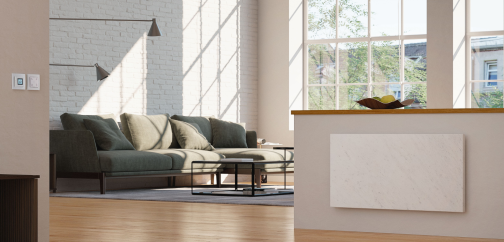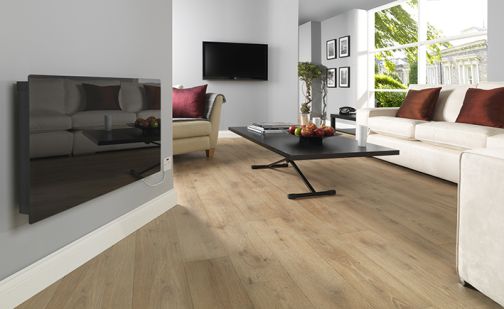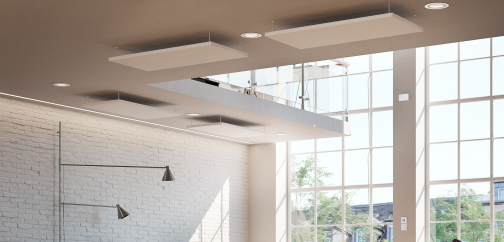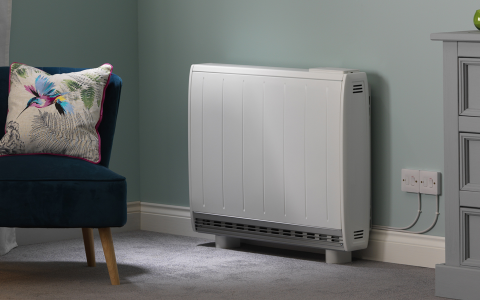
Debunking the misconceptions of electric panel heating

In this post we will explore the following four main misconceptions of panel heaters and why they exist and what the reality is:
- They are powered by “dirty fuel”
- They are expensive to run
- They have a lack of control, negatively affecting user comfort
- Their design is dated and lacks a modern feel
Currently, around 2.1 million homes in the UK use electricity as their primary form of heating and approximately 400,000 of those homes utilise only direct acting panel heaters. The electrification of heating plays an integral part in decarbonising heat in homes, both in the renovation of existing buildings that use fossil fuels, and also in the more than 200,000 new homes built in the UK each year. If we are to reach the UK’s net zero 2050 target, the specification of electrified heating solutions in existing homes and new developments will need to increase rapidly. This electrification will be primarily led by heat pump technologies, however there are scenarios where the specification of panel heaters will be beneficial and necessary, so it is important to dispel myths that surround them.
Are electric panel heaters powered by “dirty fuel”?
Being 100% efficient at the point of use, the carbon factor of panel heating reflects that of the electricity supply grid. Carbon emissions emitted when burning a unit of natural gas or oil cannot change significantly as their basic carbon content is inherent. However, the way we generate electricity has changed dramatically. UK coal and gas fired power stations are being phased out altogether and are being replaced by offshore wind and solar energy generation. Because of this the carbon factor of electricity is falling quickly. This significant decarbonisation of the grid in the past few decades means that the carbon factor of electricity is now lower than that of gas and other fossil fuels.
To demonstrate this, we should look to SAP, the building energy and carbon model that is used to demonstrate compliance with Part L. In this model the carbon factor of each fuel is determined. Given that the carbon factor values have not been updated since 2012 the decarbonisation of electricity has not yet been truly reflected in carbon emission calculations. The updated SAP 10 puts this imbalance right. The carbon factor of oil has not changed and remains at 0.298, while gas has reduced slightly from 0.216 in SAP 2012 to 0.210 in SAP 10.1 marking a decrease of 2.8%. The carbon factor of electricity has reduced by a massive 73.8%, taking it from the highest of the three fuels, at 0.519 in SAP 2012, to the lowest at 0.136 in SAP 10.1. As the decarbonisation of the grid continues, panel heaters will become progressively low carbon options for space heating in new and existing developments in the future, until 2035 - at which point the electrical grid will be zero carbon.
Is electric heating in modern buildings expensive?
Improvements in the thermal efficiency of building fabric means that heat loss in modern developments is relatively low. The energy demand for space heating in well insulated buildings is therefore significantly reduced. Where insulation levels are high, the specification of panel heating in smaller houses and low-rise apartment buildings can result in a better combined capex/opex performance than many other technologies. It is the correct consideration of the building services within the design and use of the building which defines the best solution, not simply the review of performance of one technology against another. Combining direct acting panel heaters with a hot water heat pump to make use of renewables for this larger energy demand, for example, will be an excellent solution for many UK properties new and existing.

Hybrid technology - Combining direct panel heating with hot water heat pumps
The combination of direct acting panel heaters with hot water heat pumps can be attractive for both new projects and retrofit. The primary energy load in a well-insulated building is hot water and this can be managed by technology such as the Edel Hot Water Heat Pump with a coefficient of performance of 3.36 (according to EN16147). This can provide significant CO2 and operational cost reductions over traditional and alternative system specifications.
Although the capital cost of hybrid electric technology will be higher than the cost of direct acting electric systems alone, it will also be significantly cheaper than an installation of a full heat pump solution. To find out more about the benefits of hybrid electric technology, read our latest case study.
To further reduce operating costs, complementary technology, such as high heat retention storage heaters, can be utilised in some scenarios. Modern storage heaters are essentially a thermal energy store and are designed to draw cheaper electricity at times when production is high and costs are low, storing it to heat space as the occupants require, typically at peak periods when the cost and carbon factor of that energy is greater. This is ideal for specification in existing homes, in rooms that are more frequently occupied.
Do modern electric panel heaters suffer from poor user control?
The specification of user control for modern panel heaters has changed drastically with the introduction of the EU EcoDesign legislation. To achieve compliance, fixed panel heaters over 250W must have an efficiency rating over 38%, which is achieved through accuracy of controls, and application of energy saving features. These can include electronic room temperature controls, and weekly programmers with large, user-friendly digital screens.
To achieve additional energy savings, many modern panel heater manufacturers incorporate intelligent controls into their products. Features such as open window sensing technology and eco or warm-up technology (also called predictive start) can monitor room temperature and adjust the heater function to avoid waste and save energy. Central or wireless zone control is also often available with higher range heating systems, and all these technologies help to ensure the space is heated only when occupants require it, minimising energy use; and therefore, cost and carbon.

How do electric panel heaters fit with modern, contemporary design?
The design of electric panel heaters has come a long way from the traditional look, comprising two pressed pieces of metal with visible mechanical parts. The modern range designs, colours, and the addition of intuitive control units, give panel heaters a contemporary appearance sought after in modern developments. A variety of materials, often recycled, are used for manufacture. These can include various colours and finishes of metal and glass. Electric panel heater units based on the design of wet radiators are popular in period properties and where a more industrial look needs to be achieved. Modern panel heaters are generally much slimmer than their predecessors, allowing for better utilisation of living spaces. The added benefit of their design over a traditional wet systems is the fact that there is no need for unsightly pipes.
Dimplex has been at the forefront of technology innovation for heating, cooling, and ventilation for over 50 years. Our diverse range of low carbon solutions, designed to create a sustainable future includes heat pump technologies, direct acting panel heaters and high heat retention storage heaters. To find out more about our ranges or discuss your project in more details, contact our HVAC specialists.











